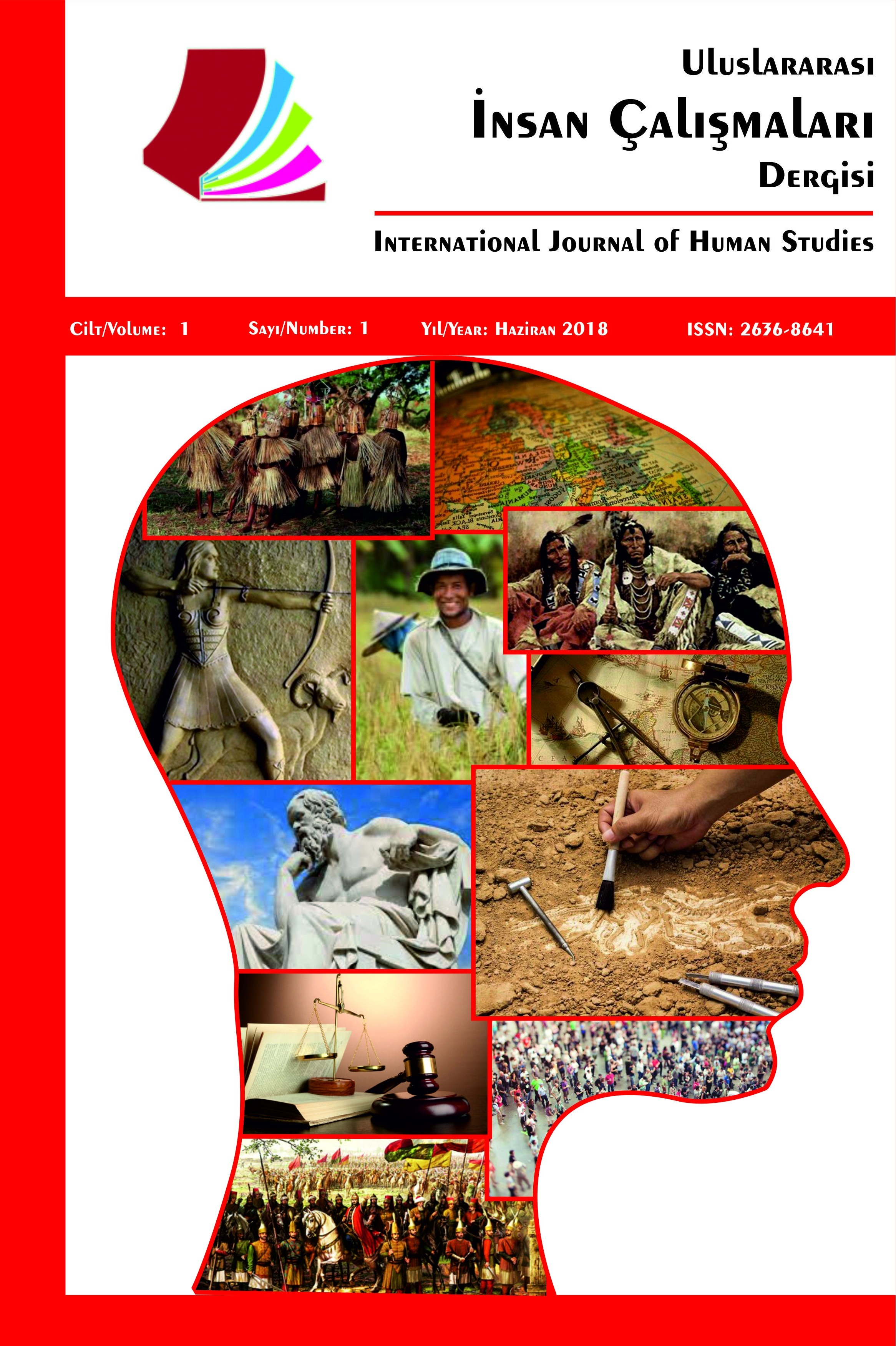Erken Amerikan Edebiyatından İki Öykü: Irving’in “Başsız Süvari” ve Austin’in “Peter Rugg”ında Gotik
On dokuzuncu yüzyılın başlarında Amerikan edebiyatında erken örnekleri bulunan kısa öykü türünün neredeyse bir Amerikan ulusal edebi türü haline gelmesinin temel nedeni, kısa sürede tüketilmeye uygun bir uzunluğa sahip olması ve bir oturuşta okunabilmesi, bu nedenle hızlı ve aktif bir yaşam tarzı süren Amerikalı için daha cazip olmasıdır. Ayrıca söz konusu bu dönemde bu türde yer alan gotik unsurlar dikkat çekmektedir. Amerikan edebiyatındaki gotik öykülerin ilk örneklerinde kurgunun karakterin evi ya da şehir, köy ve sokaklar olduğu görülmektedir. Bu çalışmada, bu dönemde eser veren yazarların erken dönem gotik örnekleri, Washington Irving ve William Austin'in öyküleri incelenmekte ve bu öykülerden hareketle dönemin edebiyatındaki gotik unsurlar ele alınmaktadır. Gotik unsurlara sahip hikâyeleri de dâhil olmak üzere birçok edebi üslubu denemiş olan Irving'in eserleri, yazarın gizem, korku ve doğaüstü olan yakınlığını sergileyen genellikle sade ve mizahi eserlerdir. Amerikan kısa öyküsünün ilk ve en önemli yapıtlarından biri olan “Başsız Süvari”, gotik unsurları ironi ve gizemli üslupla bir araya getiren sürükleyici kurgusu ile tanınırken, tarihsel etkileriyle de dikkat çekmektedir. Daha sonra Poe, Melville ve Hawthorne tarafından geliştirilecek olan belirli temaların başlatıcısı olarak görülebilecek ve Amerikan mekânları için efsanevi bağlantılardan oluşan bir doku yaratan Austin'in “Kayıp Adam Peter Rugg” öyküsü, her bakımdan Amerikan kısa öyküsünün gelişiminin erken bir örneğidir. Burada incelenen eserler, gotik ve erken Amerikan kültürü ve yaşam tarzı arasındaki paralellikler bağlamında öneriler sunmaktadır. On dokuzuncu yüzyılın başlarındaki gotik öykülerin ortak özellikleri ve özgün dokularıyla Amerikan edebiyat tarihinde önemli bir yer tuttuğu görülmektedir.
Two Early American Short Stories: Gothic in Irving's "The Legend of Sleepy Hollow" and Austin's "Peter Rugg"
The main reason why the short story, with early examples in American literature in the early nineteenth century, became almost an American genre is that it had an appropriate length to be consumed quickly and can be read in a single sitting, so it was more appealing to the American who led a fast and active lifestyle. Moreover, gothic elements in the genre in this period draw attention, and it is seen that in the early examples of gothic stories in American literature, the setting is the character's house or the city, village, and streets. In this study, early gothic examples of writers who produced works in this period, Washington Irving's and William Austin's stories are examined and the gothic elements in the literature of the period are discussed on the basis of these stories. Experimenting with many literary styles, including his stories with gothic elements, Irving's works are simple in tone and humorous, displaying the author's affinity for mystery, horror, and the supernatural. “Legend of the Sleepy Hollow”, one of the first and most important works of American short story, is known for its gripping fiction, combining gothic elements with irony and mysterious tone, and it also draws attention with its historical effects. Creating a fabric of legendary connections for American spaces that could be seen as initiating certain themes that would later be developed by Poe, Melville, and Hawthorne, Austin's story “Peter Rugg” is in every respect an early example of the development of the American short story and gothic literature. The works examined here offer suggestions in the context of parallels between gothic and early American culture and lifestyle. It can be stated that the gothic stories of the early nineteenth century are important in the history of American literature with their common characteristics and unique textures.
Keywords:
Austin, Irving, Gothic, Short Story, America,
___
- Referans1 Adkins, N. F. (1925). William Austin, the creator of Peter Rugg. Modern Language Notes, 40(7), 435-438.
- Referans2 Austin, W. (1999). Peter Rugg, Kayıp adam. Kısa Amerikan Hikâyeleri. Çev. Şirin O. Yener. İstanbul: Doruk Yay.
- Referans3 Burstein, A. The Politics of Sleepy Hollow. Erişim Tarihi: 12.04.2021, www.nytimes.com/2005/10/30/opinion/nyregionopinions/the-politics-of-sleepy-hollow.html?pagewanted=all.
- Referans4 Geoffroy, A. (1996). Mais qui était donc Peter Rugg? Sources historiques cryptées d'un écrit fantastique révolutionnaire. Revue Française d'études Américanes, 68, 87-97.
- Referans5 Greven, D. (2004). Troubling our heads about Ichabod: “The Legend of Sleepy Hollow”, Classic American culture, and the sexual politics of homosocial brotherhood. American Quarterly, 56(1), 83-110.
- Referans6 Higginson, T. W. (1921). Letters and journals of Thomas Wentworth Higginson, 1846-1906. Boston: Houghton Mifflin Company.
- Referans7 Hughes, R. (2005). Sleepy Hollow: Fearful pleasures and the nightmare of history.” The Arizona Quarterly. 61(3), 1-26.
- Referans8 Hoffman, D. G. (1953). Irving's use of American folklore in “The Legend of Sleepy Hollow”. PMLA, 68, 425-435. DOI: 10.2307/459863.
- Referans9 Irving, W. (2007). Başsız Süvari. Çev. Dilek Şendil. İstanbul: Merkez Kitapçılık.
- Referans10 Nepomnyashchy, C. T. (1999). Pushkin's The Bronze Horseman and Irving's “The Legend of Sleepy Hollow”: A curious case of cultural cross-fertilization?” Slavic Review, 58(2), 337-351.
- Referans11 Zimbalatti, J. A. (1992). Anti-Calvinist allegory: A critical edition of William Austin's “Peter Rugg the Missing Man” (Yayınlanmamış Yüksek Lisans Tezi). Fordham Üniversitesi, New York.
- Başlangıç: 2018
- Yayıncı: Zeynel KARACAGİL
Sayıdaki Diğer Makaleler
Mary Wollsonecraft'ın “Kadın Haklarının Gerekçelendirilmesi” Kitabının İncelenmesi
Mehmet Fatih IŞIK, Ayşe Merve Nur MUYAN
Umutsuzluğun Yaşam Doyumu Üzerindeki Etkisi: Benlik Saygısının Aracı Rolü
“Shakespear’den Daha İyi?”: G. B. Shaw’un Postmodernizmi ve Shakespeare
Ortaokul 8. Sınıf Öğrencilerinin Özgürlük Algıları
Doğuşundan Ölümüne, Yok Oluşundan Dirilişine Yazar Figürünün Tarihsel Değişimi
Hamdi Gökçe ZABUNOĞLU, Esma Yağmur SÖNMEZ
Erken Amerikan Edebiyatından İki Öykü: Irving’in “Başsız Süvari” ve Austin’in “Peter Rugg”ında Gotik
